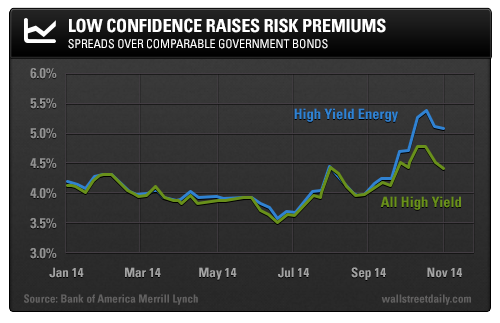High-yield bonds, also known as junk bonds, issued by U.S. energy companies have come under selling pressure in recent weeks as Crude Oil prices have fallen to lows not seen since mid-2009.
Bloomberg says investors in these bonds are facing $11.6 billion in losses at the moment. Energy company-related debt issued in the past three years alone – about $90-billion worth – is down on average about 13% since oil hit its 2014 high in June.
That doesn’t compare favorably with the average junk loss in the $1.3-trillion junk bond market during that period of 2.2%. Overall for the year, the total return on energy junk bonds is -5.5%, while the average high-yield bond total return is 3.08% in 2014.
This selloff means that the average energy junk bond now yields more than 8.5%! That is the highest yield seen since July 2010, up from an average 5.67% yield in June 2014.
Investors seem to be asking no questions, just selling these bonds. I think a closer look at the situation is warranted.
Bonds Turn Sour
Much of the expansion in the domestic shale energy industry was funded by high-yielding bonds issued by companies such as SandRidge Energy (NYSE:SD), Energy XXI (NASDAQ:EXXI), and Halcón Resources (NYSE:HK).
So many of those bonds have been issued that the junk bond market in the energy sector has doubled in size since 2008. According to Dealogic, that expansion continued early this year, leading to energy-related junk bonds accounting for 18% of the total high-yield issuance in 2014.
Today, these bonds make up 17% of the benchmark Bank of America Merrill Lynch High-Yield Bond Index.
But there’s a problem. Lower oil prices – which are down 37% year to date – are squeezing many of the smaller U.S. exploration and production companies in the shale gas and oil industry. The squeeze is being felt by players in the most expensive regions to operate in, where companies need at least $60 a barrel to break even.
The pressure is occurring because the amount of money an energy company can borrow is tied directly to the value of its reserves. The lower oil goes, the less the reserves are worth.
Thus, some are questioning the state of funding at certain companies and whether they’ll be able to pay back the money they borrowed through the issuance of these junk bonds.
This concern is reflected in the spread between these bonds and similarly mature U.S. Treasury securities.

The high-yield bonds of oil service companies that get much of their revenue from exploration and production firms have also been under extreme pressure.
In fact, their performance has been far worse, with oil service company junk bonds down 7.1% and oil equipment company junk bonds lower by 9.1%.
That leads to the question of whether there is any way to escape the carnage in the energy bond sector.
Stick to Infrastructure
The answer is, “Yes…” if investors stick to energy infrastructure.
The bonds of pipeline and refinery companies have outperformed their energy brethren.
The Financial Times says, “Lower-rated debt issued by pipeline operators and oil refiners has generated a better total return than the broad junk market’s gain of 3.5% so far this year.”
Junk bonds issued by pipeline companies are up on average a tidy 10.2% in 2014, while similar bonds issued by refiners are higher by an average of 5.5% this year.
The bottom line: If an investor is searching for high yield in the energy bond sector, stick with the infrastructure. The cash flow there is much more stable, almost utility-like, ensuring a better chance that the bond will be paid back.
And “the chase” continues,
BY Tim Maverick
